Observations on the largescale structure of the Universe over the past decades have given rise to the notion of the ‘cosmic web’, which is nothing if not the cosmic electricity grid of the Electric Plasma Universe Dr. Mae-Wan Ho
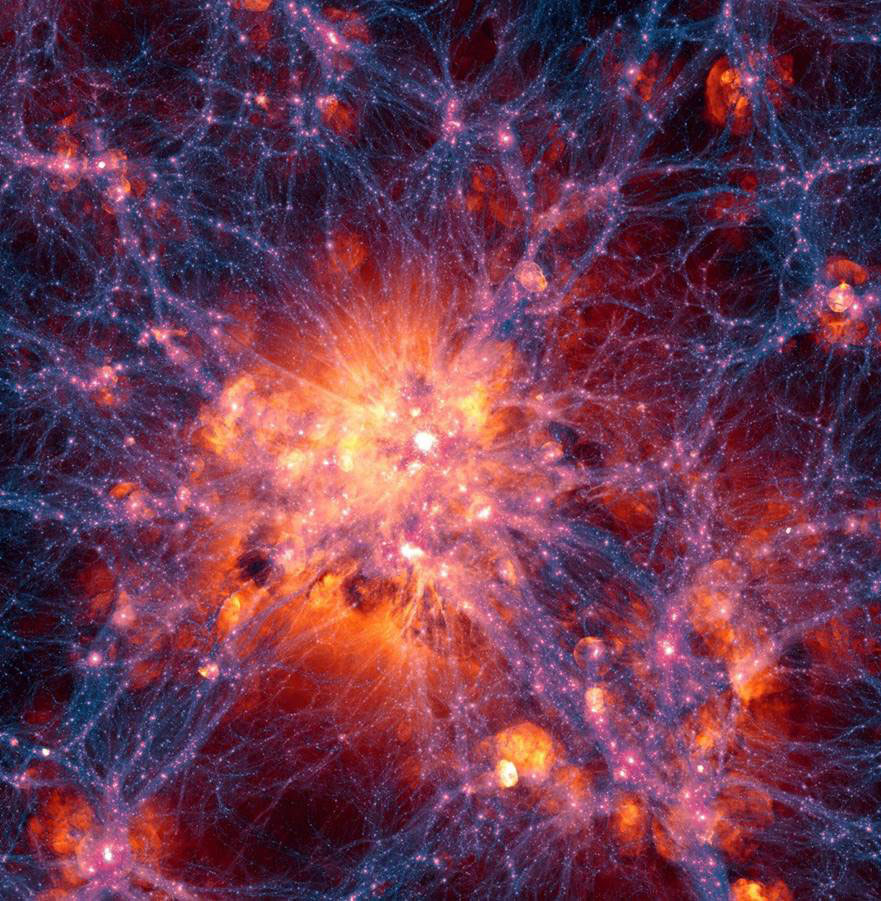
The cosmic web
There is no starker contrast between the Big Bang and the Electric Plasma Universe (see [1] Continuous Creation from Electric Plasma versus Big Bang Universe, SiS 60). Big Bang cosmology developed when the Universe could only be seen dimly through light emitted in the visible electromagnetic spectrum, a narrow band less than one octave between 390 and 700 nm. Since the 1970s, space research has extended our vision enormously in an electromagnetic spectrum spanning some 30 octaves - from radio waves, microwaves, and infrared at one extreme to ultraviolet, x-rays and γ-rays at the other, all emitted by magnetized plasmas, and on timescales of split seconds to minutes, hours, and days. A cosmic extravaganza is enacted with the immediacy of happenings before our wide-open sleepless telescopic eyes. X-ray bursts change by orders of magnitude within milliseconds, some 1010 times faster than emissions in the visual range.
Instead of a static Big Bang Universe stuffed with dead dark matter and dark energy, the Electric Plasma Universe is alive and shimmering, flashing, often bursting with unrivalled brilliance, here, there, and everywhere we look. It is buzzing with [1] “electric-plasma currents accreting and concentrating mass and transferring energy over galactic and intergalactic distances, organizing space into cells surrounded by sheets and filaments of plasma bounded by electric double layers. The circuit paths are closed, sometimes over very large distances. Plasmas in relative motion in one part of the universe can produce prodigious amounts of electrical energy, and the energy transferred over many billions of light years to suddenly burst from a very small and localized region.” This was essentially the vision of Hannes Alfvén, father of astrophysics and the Plasma Universe [2]. It naturally leads to the idea of a cosmic electricity grid (see [3] Many Things New around Our Electric Sun, SiS 68). Unlike ordinary electricity grids, the cosmic grid of electric plasma transmission lines not only actively constructs itself, but also creates galaxies and stars from stardust in the process.
Alfvén’s vision has been lavishly validated by detailed astronomical observations. Optical redshift surveys, such as the Sloan Digital Sky Survey, have long revealed the complex filamentary network that characterizes the large scale structure of the Universe. The vast majority of galaxies reside in filaments and walls of plasma, the former having dimensions of many tens of Mpc (megaparsec) in length and 1-2 Mpc in thickness (1 parsec = 3.26156 light years = 3.086 x 1013 km). The clearest example is The Local Group of galaxies that includes the Milky Way, which appear to lie along an extended filament originating near the Ursa Major group that includes both the IC342 and M81 groups, and a second primary filament that includes the Sculptor group and originates near the Virgo cluster. The Virgo Cluster itself resides in the centre of the Local Supercluster, a collection of galaxies, groups, clusters, filaments and voids within 50-100 Mpc of the Local Group [4]. This is just the hierarchical fractal structure expected of a cosmic electricity grid [3]. These observations have given rise to the notion of the ‘cosmic web’ (in effect the cosmic electricity grid, though still not generally recognized), an enormous network with dense regions of galaxy cluster and groups, sparsely populated regions or voids, as well as filaments that appear to link up the whole.
Two recent big cosmological surveys (COSMOS and HiZels) plus data from several telescopes have helped to identify the filaments linking large parts of the distant universe when it was “half its present age” [5]. The main finding is that galaxies residing in the cosmic web filaments have a much higher chance of actively forming stars; as would be the case if these filaments were correctly identified as field-aligned Birkeland currents of galactic and intergalactic dimensions (see [6] Electric Plasma Universe Arrives, SiS 68). Instead, using a new computational method that claims to map dark matter based on ‘gravitational lensing’, the researchers have attributed the filaments to dark matter itself, which is said to be responsible for organizing the universe. Unfortunately, the methodology of gravitational lensing is disputed, as refraction by cold gas clouds has also been considered responsible for lensing effects [7]. More seriously, there is to-date no evidence that dark matter actually exists despite strenuous efforts dedicated to detecting it [8]; and its theoretical existence is contradicted by many observations (see for example [9-11]).
Not only are star more likely to form along cosmic filaments, the filaments determine the spin axis of galactic centres, as they would if galaxies are created from galactic scale Birkeland currents in the Electric Plasma Universe (see [1]). New observations with European Southern Observatory’s Very Large Telescope (VLT) in Chile revealed alignments over the largest structures ever discovered in the Universe, Gpc (Gigaparsec) scale quasar groups at redshift z ~ 1.3 [12, 13]. (Redshift is the increase in the wavelength of spectral lines emitted by astronomical objects, which is assumed to be proportional to distance from Earth, and hence also its age, but the assumption breaks down for redshifts > 0.3, as explained in [14] Galaxy Making Stars at the Edge of the Universe and Other 'Surprises', SiS 60). A European research team found that the rotation axes of the ‘central supermassive black holes’ in a sample of quasars are parallel to each other over distances of billions of light-years, tending to align with the vast filamentous structures in the cosmic web in which they reside.
Within Big Bang theory, quasars are [12] “galaxies with very active supermassive black holes at their centres. These black holes are surrounded by spinning discs of extremely hot material that is often spewed out in long jets along their axes of rotation. Quasars can shine more brightly than all the stars in the rest of their host galaxies put together.” The description is fine except for the ‘supermassive black holes at their centres’.
The new VLT results indicate that the spin axes of the quasars are not only parallel to one another they tend to be parallel to the large-scale structures in which they reside. So, if the quasars are in a long filament, then the spins will point along the filament. The probability that these alignments are simply due to chance is less than 1 %.
The rotation axes or the jets cannot be seen directly. They are inferred from the polarisation of light measured from each quasar and for 19 of them, a significantly polarised signal is found. The direction of the polarisation, combined with other information, could be used to deduce the angle of the central disc and hence the direction of the spin axis of the quasar.
“The alignments in the new data, on scales even bigger than current predictions from simulations, may be a hint that there is a missing ingredient in our current model of the cosmos,” concludes Dominique Siuse of Argelander-Institut fűr Astronomie in Bonn, Germany.
The putative supermassive black hole at the centre of galaxies may turn out to be nothing more than a supermagnetic field typically found on top of it (see [15] Supermagnetic Field or 'Supermassive Black Hole', SiS 67), and such a strong magnetic field would be created in the formation of galaxies when two (or more) galactic scale Birkeland currents come together through mutual attraction to form galaxies (see [16] How the Plasma Universe Creates Galaxies and Stars, SiS 68).
In his monograph Cosmic Plasma published in 1981, Alfvén stated [17]: “In order to understand the phenomena in a certain plasma region, it is necessary to map not only the magnetic but also the electric field and the electric current.” He had repeatedly emphasized that magnetic fields are generated by electric currents, and the idea of ‘frozen in magnetic fields’ was simply incorrect, because of electric circuits and electric double layers in the cosmic transmission lines.
In 2011, researchers analysing a cosmic jet ‘2 billion light years away’ found it carries the biggest electric current ever seen, 1018 Amperes, equivalent to a trillion bolts of lightning [18, 19]. Astrophysical jets are elongated beams shooting out of the compact centres of galaxies and stars, often in pairs in opposite directions. They have been resolved with radio, optical and X-ray telescopes. The material in these jets can travel at close to the speed of light, and some remain tightly collimated (focussed) for hundreds of thousands of light years.
Philipp Kronberg at University of Toronto in Canada and colleagues first measured magnetic field by means of Faraday rotation around the galaxy 3C303, which has a giant jet of matter shooting from its core [19]. (Faraday rotation is the rotation of the plane of polarized light by a magnetic field, the amount of rotation being proportional to the strength of the magnetic field.) They saw a sudden change in polarization coinciding with the jet. “This is an unambiguous signature of a current,” said Kronberg [18].
The team believe magnetic fields from a colossal black hole at the galaxy’s core are generating the current, which is powerful enough to light up the jet and drive it through interstellar gases out to a distance of about 150 000 light years. However, they also stated that their analysis [19] “strongly supports a model where the jet energy flow is mainly electromagnetic.”
Kronberg and co-authors observed that in general astrophysical jets are initially highly relativistic and low density, and therefore thought to be magnetically dominated or force-free with a negligible fraction of power in particle kinetic energy [19]. The energy outflow from the accretion disk is in the form of a collimated “Poynting-flux jet”, i.e., a jet due to electromagnetic flux, most likely, the condition of a field-aligned Birkeland current, although they did not say so. The model developed has a current outflow (or inflow) Iz along the spine of the jet. The associated toroidal magnetic field is responsible for collimating the jet. An equal but opposite return current flows at much larger distances from the jet axis is included so that the net current outflow from the source is zero.
The return current in the model forms a large bubble or cocoon around the jet. According to Gregory Benford at University of California Irvine, current-carrying jets must necessarily have their return currents carried in the volume of the cocoon because it is energetically efficient to induce flows in many particles at low velocity. This large, mass-loaded cocoon can preserve confinement of plasma through its self-organized magnetic configuration (presumably an electric double layer protecting itself from the environment). Benford has proven a theorem that such cocoons can be stable, even after the jet turns off [20].
Indeed, two large symmetrical cocoons were discovered at the centre of our own galaxy the Milky Way, one above and the other below the galactic plane, which had shown no sign of activity previously. But the Fermi Gamma-ray Space Telescope has picked up signs of γ-ray jets inside the cocoons two years later [21, 22] (Figure 1). According to Douglas Finkbeiner and Meng Su at Harvard-Smithsonian Center for Astrophysics in Cambridge, Massachusetts, the jets may also be responsible for the two giant γ-ray emitting bubbles of gas reported in 2010 using the same telescope. Both the bubbles and the jets originate near the centre of the Milky Way and extend about 8 278 parsecs (27 000 light years) outward. Both features are thought to be powered by electrons traveling close to the speed of light, which collide with low energy photons and boost the photons to γ-ray energies. The bubbles are oriented perpendicular to the flat plane of the Milky Way, whereas the jets shoot out at an angle of about 15 degrees. The tilt suggests that the black hole may itself be tilted, the researchers said [21]. “That in turn could reflect the orientation of the black hole’s spin.” And the black hole could have been active as recently as 20 000 years ago.
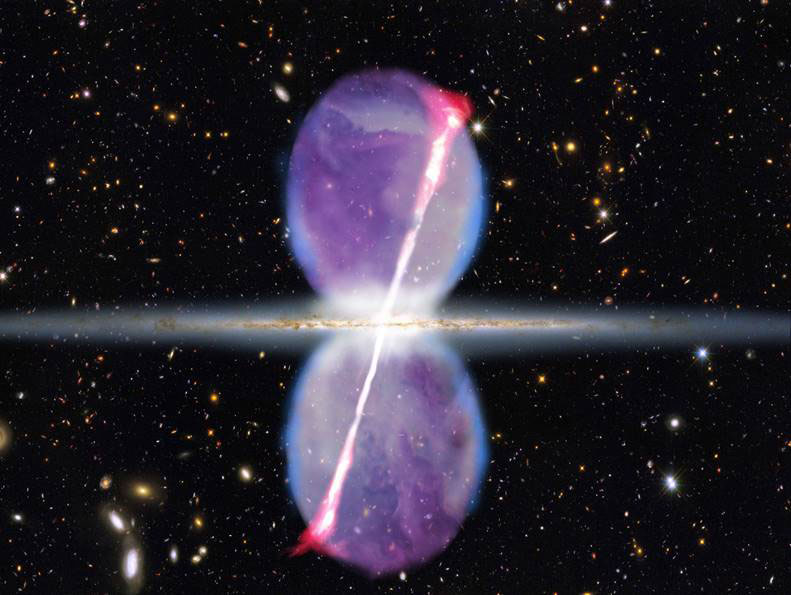
Figure 1 Artist’s representation of jets and magnetic cocoon at the centre of Milky Way
Another remarkable example of double jets is found in the galaxy Cygnus A (Figure 2). The galaxy itself (a few kpc across) is invisible in radio waves except for its active centre, which is connected to gigantic radio lobes, possibly magnetic cocoons, by exceptionally long (40 kpc) thin jets.
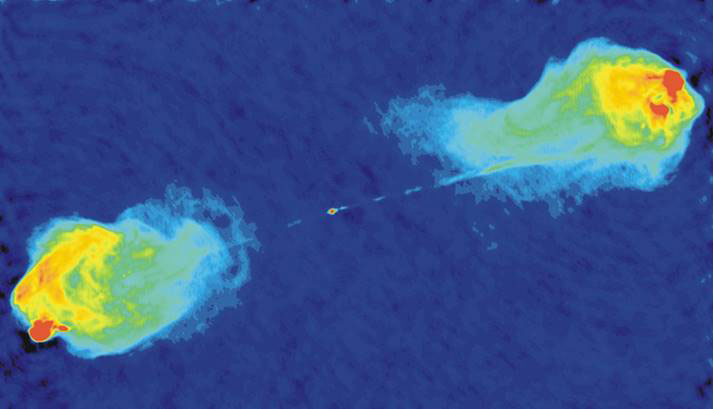
Figure 2 Radio image of Cygnus A dwarfed by huge double radio lobes at the ends of bipolar jets; red spots are very bright “hotspots”
It is clear that the circuit between the jet (essentially a collimated Birkeland current) and its cocoon (perhaps a sheet Birkeland current around the periphery of the cocoon) could account for the stability of both, in terms of known properties of electric plasmas, without any help from hypothetical supermassive black holes. This is demonstrated in laboratory experiments such as those carried out at Imperial College London, using a predominant toroidal magnetic field to form a magnetically driven jet [23] (Figure 3).
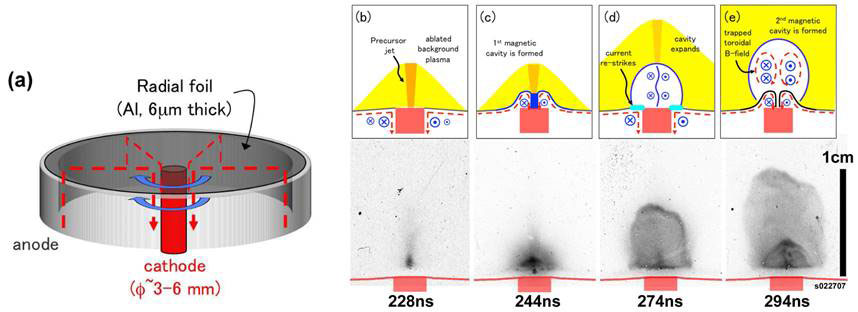
Figure 3 Astrophysical jet experiment (a) the radial foil and electrodes; (b) to (e) Formation of episodic magnetic cavities and jet shown schematically (top) and from XUV self-emission from the plasma (bottom); red arrows represent the current paths, blue arrows the toroidal magnetic field
The experiments were conducted in the MAGPIE generator, which produces a current pulse of 1.5 MA in 250 ns. The current is introduced into a radial foil, an aluminium disc 6-15 µm thick. The foil is placed between two concentric electrodes as the load of MAGPIE, with the central electrode having a selection of diameters between 3-6 mm. The current path along the electrodes and the foil generates an initial toroidal magnetic field, which can reach ~100T at the radius of the cathode (Fig. 3a). The overall dynamics are shown schematically as well as from XUV emission images (Fig. 3 b to e). As the current increases, the foil is heated and converted into plasma, a process that lasts for the first 100 ns. The plasma is ablated from the foil following the direction of the J x B (Lorentz) force pointing in a direction normal to the foil surface. This forms low-density background plasma above the foil (Fig. 3b). The Lorentz force is strongest towards the radius of the cathode, and thus a fastest rate of ablation in this region leads to the formation of a radial gap due to the complete ablation of foil material. Plasma is then driven upwards by the magnetic pressure beginning to form a magnetic cavity, with the toroidal magnetic field now moving to a new position above the initial surface of the foil (Fig. 3c). The cavity expands into the ambient plasma due to the magnetic pressure inside, and the toroidal magnetic field inside the cavity confines a plasma jet on the axis (Fig. 3d). It is possible to produce subsequent magnetic cavities (cocoons) in the same experiment. This occurs as the current restrikes at the base of the first magnetic cavity. This is illustrated in Fig. 3d-e. This process is repeated throughout the duration of the current pulse, typically producing 3-4 magnetically driven jets (and accompanying cocoons) per experiment.
The missing element from the theoretical model of the astrophysical jet is the generator, which in the lab experiment is provided by the MAGPIE generator. In the case of the galaxy, it is the rotating centre itself, as Alfvén had envisaged. Alfvén started from a (largely correct) model of the aurora circuit powered by plasma near the equatorial plane rotating with Earth thereby moving across Earth’s magnetic field lines and producing an electromotive force giving rise to field-aligned currents that discharge in the aurora zone of the ionosphere above the poles. The same circuit was then applied to the heliosphere, in which the rotating and magnetized Sun acts as a homopolar generator producing currents that go out at the poles and return inward in the equatorial plane (see [3]). The model was generalized to a galactic circuit in which the galactic centre, also magnetized and rotating, acts as the homopolar inductor/generator (Figure 4) [24].
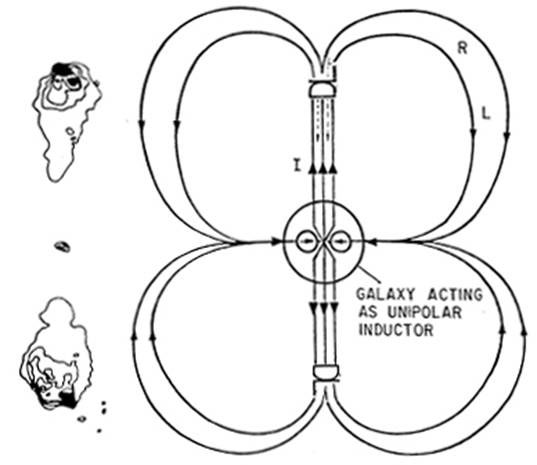
Figure The galactic circuit according to Alfvén in which the rotation and magnetized galactic centre acts as a inductor/generator; example of a double radio source mapped on the right
The electromotive force derived from the galactic rotation supplies two similar circuits, one to the ‘north’ and the other the ‘south’ of the galaxy. Double layers (DL) would also be expected in the outgoing field-aligned currents which would be responsible for accelerating electrons and producing the double radio sources so frequently associated with astrophysical jets and active galaxies.
Article first published 19/10/15
Comments are now closed for this article
There are 4 comments on this article.
Sarah Parker Comment left 20th October 2015 05:05:42
Fascinating, was not aware of any of this, shows how mainstream media keeps old assumptions in play and downplays new findings very often. Thanks, Mae-Wan.
Dr.Mike Godfrey Comment left 20th October 2015 05:05:58
Shades of Tesla! He showed that there was more than enough available energy in a cubic metre of space to provide unlimited electric power and demonstrated it with a Pierce-Arrow car fitted with a Tesla motor that reportedly could do 90mph day or night. His driver was interviewed many years later and confirmed it.
Warren Taylor Comment left 20th October 2015 15:03:34
Great article as always. Thought this may be of interest.
EVERYTHING IS SOUND AND LIGHT: IS OUR CONSCIOUSNESS CONFINED TO A HOLOGRAPHIC SIMULATION?
A contemplative exploration into the inner essences of creation, the nature of matter, energy, time, space, and the consciousness which witnesses these phenomena. http://themindunleashed.org/author/andrewtmu
Roy Niles Comment left 24th October 2015 15:03:58
Perhaps the authors could take one step further and recognize that this may be how an intelligently operated and constructed universe has, by trial and error, evolved itself to work - then take another step to see that to be intelligent at all, or have need to be, a variety of competitive as well as cooperative forces must have effectively evolved themselves as well.